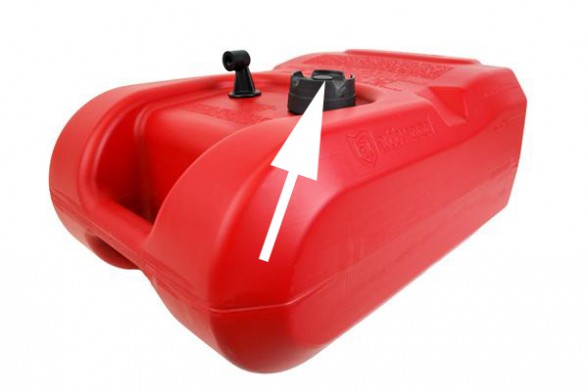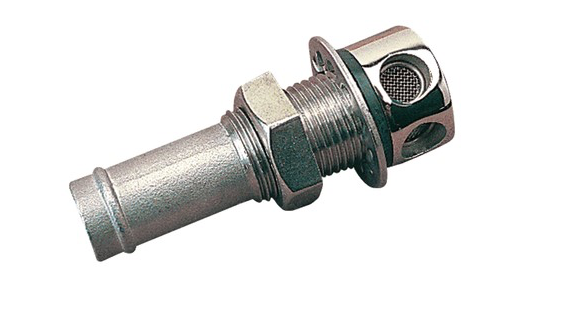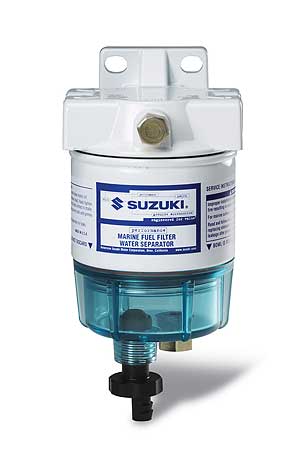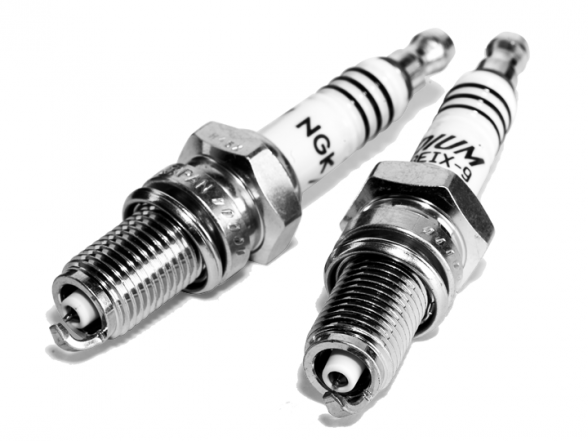Outboard Runs Then Runs Half Speed Then Runs Again
With the appearance of solid-state ignition, fuel injection, and a host of other technologies, today'southward two- and four-stroke outboards are more reliable than they've ever been. They're so dependable, in fact, that we oft take their reliability for granted. Still, in that location are others of us out there that have older, more than temperamental outboards and, believe it or not, even relatively new outboards can act up at times. Information technology's related to Potato's Law of Boats.
Then, what should you exercise when your outboard engine is puttering instead of purring? Luckily there are some common reasons outboard engines deed up, and nigh of the solutions don't involve getting an expensive mechanic involved. Some issues can even be solved with the twist of only ii fingers. Read on to find out nearly some steps to take when your outboard'due south got an mental attitude trouble.
Check the Tank Vent and Hoses
If we had a dollar for every fourth dimension our boats started sputtering and running rough because we forgot to open the fuel vent on our portable fuel tanks, well, we'd have quite a few bucks rolling around. If you've got a portable tank and your engine is misbehaving, the first affair you want to exercise is bank check to make sure the valve on your portable tank is fully open up. If it isn't, information technology will cause your engine to go fuel starved, run crude, and eventually stall. Simply twist it open and monitor your engine for improvement.

If your boat doesn't have a portable tank, but instead an integral tank with a fuel vent that'southward plumbed to the outside of the boat, inspect that vent. Wasps, spiders, and other critters are well-known for bottleneck these fittings up, and that tin significantly affect engine performance. If you do detect a clogged vent, but clean it out with a pair of tweezers. If yous've got a mud wasp nest you'll desire to zap the wasp with wasp and bee killer first, so make clean out the muddy residue, trying not to get any down the fuel vent hose.
Too, check all your fuel hoses from the tank to the engine. A kinked or pinched hose tin can cause meaning performance problems in an outboard engine, especially at higher RPMs, while pinholes in fuel lines can introduce air to the fuel, besides every bit create a safety problem.


Check the Fuel Connector
Another trouble spot in the fuel delivery department—if you've got a portable tank setup—are the snap-in connectors that attach the fuel line to your outboard. A haven for corrosion, the ports inside these connectors often clog up with nasty bits of corroded, gas-soaked metal powder that can impede fuel flow. The ball bearings and cheque valves within some of these connectors can also fail.
If your outboard is running rough simply y'all've checked your fuel vent and it'due south articulate, disconnect the fuel line and give the outboard stop of the connector a proficient examination. If information technology appears OK inside but the outside is corroded and worn, consider replacing it with a new 1; in that location may be a blockage or failure you lot tin can't see inside information technology. Once y'all've replaced or unblocked the connector, reinstall it and check the engine for whatever improvement in the way it runs.
Cheque the Fuel Filter/H2o Separator
Though many smaller boats using portable tanks are not equipped with these fuel filter/water separator devices, almost boats with outboards that describe fuel from an internal fuel tank are. The purpose of these filters is not merely to filter particulate affair out of fuel earlier it reaches your outboard, but also to separate any water that may be present in your fuel. These filters sometimes become clogged or filled with water, causing an engine to run poorly.
The first thing you'll want to do is have a await at the clear sight bowl at the lesser of the filter, if this is the blazon of filter you take—some fuel filter/water separators are enclosed in a unmarried unit of measurement with no sight glass. Identify a rag, pan, or other receptacle beneath it and unscrew the drain plug to permit out any water that'south in the bowl until only gasoline is trickling out. The presence of water is a tipoff that you may have a bad load of fuel in your boat. Y'all may want to have it professionally filtered, equally the presence of too much water can cause engine problems.

Unless you lot've had it recently serviced or changed it yourself, it'due south not a bad thought to change out the filter element in the fuel filter/water separator assembly at this point, following the manufacturer's instructions for doing so. It'due south of import to annotation that one time y'all remove this filter you tin't examine it and reinstall information technology. Luckily virtually are a relatively inexpensive buy.
Some portable outboard fuel tanks have inline primary fuel filters installed in the fuel supply line, likewise. If you can't remember the terminal time you lot inverse it, you probably should go ahead and replace it. Terminal, e'er use fresh fuel. If the gasoline in your tanks has been sitting for more than than eight to 12 months, it's likely fairly dried. And, ever add fuel stabilizers designed to combat bug associated with ethanol fuel at every fill upwardly. No excuses.
Bank check/Supplant Secondary Fuel Filters
Many outboards—peculiarly newer models—have a slew of onboard fuel filters that can become clogged and detrimentally affect performance. On the simplest of outboard engines these are easily replaceable, often installed inline between the fuel inlet and the carburetor. Some smaller or older outboards may not fifty-fifty take ane. Newer, fuel-injected outboards tin accept every bit many equally 12 of these filters—two or three primaries and one or more for each fuel injector.
It'south but the primary onboard fuel filters that are possessor-serviceable on nigh modern outboards—especially larger four-strokes—and even those normally require a proprietary tool to remove them. Other fuel filters, such as those aforementioned fuel injector units, and vapor separator tank filters, should be changed past the pros. Long story brusque, if y'all tin't remember the last time the fuel filters were serviced on your boat and you lot accept an engine that'south non running so well, at present's a good time to get a fresh set up installed; it could significantly ameliorate functioning.
Check/Replace Air Filter
Smaller/older model outboard engines are commonly not fitted with an intake air filter of any sort, only plenty of newer four- and two-stroke outboard engines have them. If they become clogged with dust and dirt, this tin affect engine functioning significantly by starving the engine of air.
This is mostly an owner-serviceable part bandy, and many outboard engine owner's manuals draw how to change them. In one case you've located the filter, requite it a thorough inspection. If information technology looks dirty, or yous can't recall the terminal time it was changed, information technology'south generally an inexpensive part to swap out for a new one.
Check Spark Plugs/Ignition
Fouled or damaged spark plugs can cause all sorts of issues in any engine, much less in an outboard. Their condition can as well bespeak lurking internal bug, likewise. If yous've eliminated fuel problems and air issues, consider pulling each spark plug and giving information technology a thorough inspection.
Plug electrodes—the ends that sit in the engine—that are worn, appear burned, or have dirty or oily deposits should exist replaced with properly gapped plugs. Concord on to your old plug(s) if they were fouled with oil or fuel gum and then have an outboard mechanic accept a look to diagnose the possibility of more serious bug inside your engine.

If you're an unlucky soul with an older outboard that has ignition curl, benefactor, rotors, spark plug wires, etc., you lot'll need to check all those components, besides as timing issues that could crusade your engine to run poorly. The good news is that there are many tutorials online for diagnosing and repairing ignition organization components in older outboards yourself, versus taking the engine into a shop for repairs.
Check/Clean Carburetor
While carburetors are quickly becoming a affair of the past in outboard engines—thanks to straight injection—at that place are nevertheless plenty out there. They're awfully prone to getting gummed upwardly with fuel varnish and other contaminants, which can cause your outboard to run poorly.
The get-go and easiest affair to practise is to spray carburetor cleaner in your carburetor. You may only go lucky and this solution will knock away whatsoever gum, varnish, or debris that's causing your problems. More often than not, however, getting all the gunk out of a carburetor involves removing it, cleaning the jets, checking the seals, and so rebuilding it. There are kits your engine store tin sell you that often include these and other components needed for a rebuild. If y'all're a trivial nervous about rebuilding 1 yourself, enlist the help of an engine store pro.
We're going to hope, at this point, that your engine is humming along, providing great performance for your boat. If you're unlucky and your engine is notwithstanding running poorly after yous've systematically checked all the components mentioned above, and so it's time to go a mechanical guru from your local engine shop/dealer involved.
An inefficient boat engine may well be a source of pollution. For more than information check out our eco friendly canoeing guide. If you're unable to set your one-time engines yous can scan our huge range of outboard motors today on Gunkhole Trader.
Happy motoring!
Editor'due south Note: This article was originally published in January 2017 and was last updated in May 2021.
Source: https://www.boattrader.com/resources/troubleshooting-rough-running-outboard/
0 Response to "Outboard Runs Then Runs Half Speed Then Runs Again"
Enviar um comentário